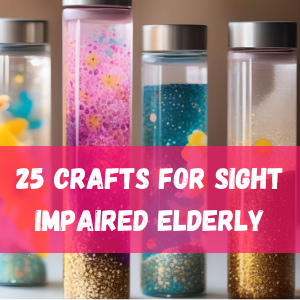Crafts for sight impaired elderly individuals can be a wonderful way to engage their senses and creativity. Here’s a comprehensive list of 25 craft ideas, each with a unique description, tailored to provide tactile, auditory, and olfactory experiences.
*As an Amazon Associate, this post contains affiliate links. If you should click and purchase something through them, I may receive a commission. This is at no extra cost to you.
Table of Contents
Tactile Sensory Bags
Create small cloth bags filled with various textured materials such as beads, rice, or fabric scraps. These bags provide a sensory exploration experience, allowing individuals to feel and distinguish between different textures through touch.
Scented Sachets
Handcraft fabric pouches filled with fragrant materials like dried lavender or cinnamon sticks. These scented sachets offer a pleasant aroma and provide tactile stimulation when touched and squeezed.
Textured Collages
Encourage individuals to create artwork using an assortment of textured materials such as sandpaper, fabric scraps, and textured paper. This tactile collage-making activity allows for creative expression while exploring different textures.
Sensory Bottles
Fill clear plastic bottles with materials like colored water, glitter, and beads to create sensory bottles. When shaken, these bottles produce visual stimulation through swirling colors and auditory stimulation through the gentle sound of moving beads.
Braille Painting
Use puffy paint to create raised designs and messages in Braille on cardboard or canvas. This tactile painting activity allows individuals with visual impairments to express themselves artistically through touch.
Tactile Puzzle
Construct puzzles using textured materials like foam, felt, or textured paper. By piecing together these tactile puzzles, individuals can enhance their cognitive skills while exploring various textures.
Scented Dough
Make scented playdough using essential oils, providing individuals with a multisensory experience. This activity stimulates the sense of touch and introduces pleasant aromas for olfactory enjoyment.
Tactile Memory Games
Create matching pairs of textured objects such as buttons, shells, or fabrics for a tactile memory game. This activity promotes cognitive function while engaging the sense of touch through tactile exploration.
Aromatherapy Necklaces
String aromatic materials like dried herbs or scented beads onto a necklace allows individuals to carry soothing scents throughout the day. These aromatherapy necklaces provide olfactory stimulation and can be a calming sensory tool.
Tactile Alphabet Cards
Use materials like craft foam or textured paper to craft alphabet cards with raised letters. This tactile activity facilitates learning and literacy skills by allowing individuals to trace and feel the shape of each letter. Individuals can use the cards or letters as creatively as they wish.
Sensory Gardens
Plant aromatic herbs like mint or rosemary in containers to create sensory gardens. These miniature gardens offer tactile and olfactory experiences, allowing individuals to touch and smell the fragrant plants. Working in a garden is also a great outlet and stress relief. It can make the individual feel connected and valued for their contributions, whether big or small.
Tactile Storybooks
Develop books with textured pages featuring different materials for tactile exploration. These tactile storybooks allow individuals to engage in storytelling while feeling the textures of various objects depicted in the illustrations.
Sensory Scarves
Sew together scarves with different textured fabrics for sensory exploration. These tactile scarves provide warmth while allowing individuals to feel and distinguish between different fabric textures.
Tactile Mosaic Art
Utilize foam or fabric to create mosaic art pieces with raised textures. This tactile art activity allows individuals to express themselves creatively by arranging textured pieces into visually appealing designs.
Scented Soap Making
Create homemade soap using scented oils and molds, incorporating textures like dried flowers or spices for visual and olfactory enjoyment. This tactile activity combines the sensory experiences of touch, smell, and sight.
Tactile Pottery
Work with clay to create textured pottery pieces such as pinch pots or coil pots. This tactile pottery-making activity allows individuals to mold and shape clay with their hands, exploring different textures as they create.
Sound Shakers
Fill small containers with materials like rice, beans, or bells to create sound shakers. When shaken, these containers produce auditory stimulation, allowing individuals to explore different sounds and rhythms.
Tactile Beading
String beads onto an elastic cord or wire to create tactile jewelry pieces. This activity promotes fine motor skills while allowing individuals to feel and manipulate various beads.
Scented Candles
Make candles using scented wax, including textures like dried flowers or spices for visual and olfactory enjoyment. These textured candles provide ambient lighting and emit pleasant aromas when lit or warmed on a candle warmer.
Tactile Weaving
Use looms or cardboard frames to weave together textured yarns and fabrics. This tactile weaving activity allows individuals to create fabric patterns while exploring different textures with their hands.
Audiobooks and Storytelling
For auditory stimulation, engage in storytelling sessions or listen to audiobooks with vivid descriptions. This activity encourages imagination and language comprehension while stimulating the sense of hearing.
Sensory Boards
For exploration, create boards with different textured materials, such as sandpaper, fur, or bubble wrap. These tactile sensory boards allow individuals to touch and feel various textures in a controlled setting.
Scented Sachet Pillows
Sew small pillows filled with fragrant materials like dried herbs or potpourri. These scented sachet pillows provide tactile and olfactory stimulation, offering comfort and relaxation.
Bird Feeders
Craft bird feeders using materials like pine cones, peanut butter, and birdseed for tactile and auditory enjoyment. This activity allows individuals to assemble bird feeders while exploring different textures and listening to the sounds of nature.
Sensory Texture Books
Make books with pages featuring different textures, such as velvet, silk, or bumpy fabric, for tactile exploration. These sensory-texture books offer individuals the opportunity to feel and explore various textures while engaging in reading activities.
These crafting ideas aim to enrich sensory experiences for sight-impaired elderly individuals, encouraging creativity, cognitive stimulation, and overall well-being. Each activity promotes engagement and enjoyment through tactile, auditory, and sense of smell.
Tactile Exploration – A Great Craft Requirement For Sight Impaired Individuals
For individuals with visual impairments, tactile exploration is paramount in crafting activities. Crafts that involve different textures, such as tactile sensory bags filled with beads, fabrics, and other materials, offer a hands-on experience stimulating the sense of touch. These individuals may also enjoy textured collages, where they can create artwork using materials like sandpaper, fabric scraps, and textured paper, allowing them to feel and distinguish between various textures as they craft.
Aromatherapy and Scented Crafts
Crafts incorporating aromatherapy and scented elements provide a multi-sensory experience for sight-impaired elderly individuals. Scented sachets filled with fragrant materials like dried lavender or cinnamon sticks offer tactile and olfactory stimulation. Additionally, scented soap making allows individuals to create homemade soaps using scented oils and textured additives like dried flowers or spices, enhancing the sensory experience through touch and smell.
Auditory Stimulation
Crafts focusing on auditory stimulation can be particularly enjoyable for sight-impaired elderly individuals. Sound shakers, filled with materials like rice, beans, or bells, provide auditory feedback when shaken, allowing individuals to explore different sounds and rhythms. Engaging in storytelling sessions or listening to audiobooks with vivid descriptions stimulates the imagination and promotes language comprehension and auditory engagement.
Sensory Integration
Crafts that integrate multiple sensory experiences can be highly beneficial for sight-impaired elderly individuals. Aromatherapy necklaces, strung with aromatic materials like dried herbs or scented beads, offer olfactory stimulation while providing a tangible accessory that individuals can wear and enjoy throughout the day. Similarly, sensory gardens planted with aromatic herbs like mint or rosemary offer tactile and olfactory experiences, allowing individuals to touch and smell the fragrant plants naturally.
Social and Emotional Connection
Beyond the sensory benefits, crafting activities also provide opportunities for social interaction and emotional connection. Engaging in collaborative crafts, such as tactile memory games or storytelling, fosters camaraderie and shared experience among participants. Creating handmade gifts, such as scented sachet pillows or tactile mosaic art, allows individuals to express their creativity and care for others, strengthening social bonds and promoting emotional well-being.
Crafts for Sight Impaired Elderly Tips for Success
Crafting activities tailored specifically for sight-impaired elderly individuals requires careful consideration and planning to ensure a meaningful and enjoyable experience. Here are some additional tips to enhance crafting sessions for this demographic:
Incorporate Contrasting Textures
When selecting materials for crafts, opt for contrasting textures that can be easily distinguished by touch. Utilize materials with distinct tactile qualities, such as smooth fabric paired with rough sandpaper or soft yarn alongside coarse burlap. Providing a variety of textures enhances sensory exploration and enables individuals to differentiate between different materials as they engage in crafting activities.
Use High-Contrast Colors
While sight-impaired individuals may have limited vision, incorporating high-contrast colors can still provide visual cues and make crafting activities more accessible. Choose materials and tools in contrasting colors, such as black and white or bright primary colors, to increase visibility and facilitate recognition. Additionally, consider using tactile markers or raised lines to outline shapes and designs, making them easier to perceive by touch.
Offer Adapted Tools and Equipment
To accommodate the unique needs of sight-impaired individuals, consider providing adapted tools and equipment designed specifically for tactile exploration. For example, tactile markers with raised dots or lines can label materials and instructions, allowing individuals to navigate crafting tasks independently. Additionally, ergonomic tools with textured grips provide better tactile feedback and improve ease of use for those with limited dexterity.
Foster Collaboration and Peer Support
Crafting activities offer valuable opportunities for social interaction and peer support among sight-impaired elderly individuals. Encourage collaboration by organizing group crafting sessions where participants can collaborate on shared projects and exchange ideas and techniques. Peer support networks can provide encouragement, inspiration, and practical assistance, fostering a sense of belonging and camaraderie within the crafting community.
Emphasize Sensory Engagement
Incorporate elements of sensory engagement into crafting activities to stimulate multiple senses simultaneously. For example, combine tactile exploration with auditory stimulation by incorporating sound-producing materials like bells or chimes into crafts. Similarly, integrate aromatherapy by using scented materials or essential oils to enhance the olfactory experience and create a multisensory environment that appeals to sight-impaired individuals.
Provide Clear and Verbal Instructions
When facilitating crafting sessions for sight-impaired elderly individuals, ensure that instructions are communicated clearly and verbally. Describe each step of the crafting process in detail, using descriptive language to convey visual information effectively. Break down tasks into manageable steps and offer guidance and support as needed to help participants navigate the crafting activity with confidence and independence.
Encourage Creativity and Personal Expression
Above all, encourage creativity and personal expression in crafting activities for sight-impaired elderly individuals. Provide opportunities for individuals to make choices and express themselves through their craft projects, whether through selecting materials, choosing color schemes, or designing unique patterns and compositions. Celebrate individual creativity and empower participants to explore their artistic talents and preferences without limitations.
Incorporating these tips into crafting activities for sight impaired elderly individuals can enhance accessibility, engagement, and enjoyment, creating enriching and meaningful experiences for all participants. By prioritizing tactile exploration, sensory engagement, and social interaction, crafts become a form of artistic expression and a source of joy, connection, and empowerment for sight-impaired individuals in their later years.

